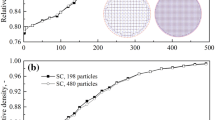Abstract
This paper deals with a computational analysis of the influence of the pressing method and part geometry on the final density distribution in the cold compaction process of ceramic alumina powders. The analysis is based on the explicit finite-element model proposed and validated in a previous study. The mechanical behavior of the processing material is described using a multisurface elastoplastic model, the modified Drucker-Prager/Cap model
Similar content being viewed by others
References
A. Baltov, “Materials sensitive to the type of process,” Int. Appl. Mech., 40, No. 4, 361–369 (2004).
S. D. Akbarov and A. N. Guz, “Continuum approaches in the mechanics of curved composites and associated problems for structural members,” Int. Appl. Mech., 38, No. 11, 1285–1308 (2002).
L. P. Khoroshun and D. V. Babich, “Stability of plates made of a granular composite with damageable components,” Int. Appl. Mech., 40, No. 7, 803–809 (2004).
A. F. Bulat, “Rock deformation problems,” Int. Appl. Mech., 40, No. 12, 1311–1322 (2004).
J. J. Rushchitsky, C. Cattani, and E. V. Terletskaya, “Wavelet analysis of the evolution of a solitary wave in composite material,” Int. Appl. Mech., 40, No. 3, 311–318 (2004).
C. Cattani, J. J. Rushchitsky, and S. V. Sinchilo, “Physical constants for one type of nonlinearly elastic fibrous micro-and nanocomposites with hard and soft nonlinearities,” Int. Appl. Mech., 41, No. 12, 1368–1377 (2005).
C. Cattani and J. J. Rushchitsky, “Nonlinear cylindrical waves in Signorini’s hyperelastic material,” Int. Appl. Mech., 42, No. 7, 765–774 (2006).
C. Cattani and J. J. Rushchitsky, “Nonlinear plane waves in Signorini’s hyperelastic material,” Int. Appl. Mech., 42, No. 8, 895–903 (2006).
J. J. Rushchitsky and C. Cattani, “Similarities and differences between the Murnaghan and Signorini descriptions of the evolution of quadratically nonlinear hyperelastic plane waves,” Int. Appl. Mech., 42, No. 9, 997–1010 (2006).
J. J. Rushchitsky and C. Cattani, “Analysis of plane and cylindrical nonlinear hyperelastic waves in materials with internal structure,” Int. Appl. Mech., 42, No. 10, 1099–1119 (2006).
A. N. Guz and J. J. Rushchitsky, “Presentation of the monographs of the S.P. Timoshenko Institute of Mechanics to the scientific community,” Int. Appl. Mech., 42, No. 3, 247–290 (2006).
A. N. Guz and J. J. Rushchitsky, “Computational simulation of harmonic wave propagation in fibrous micro-and nanocomposites,” Compos. Sci. Technol., 67, No. 4, 861–866 (2007).
J. J. Rushchitsky, C. Cattani, and E. V. Terletskaya, “Wavelet analysis of a single pulse in a linearly elastic composite,” Int. Appl. Mech., 41, No. 4, 374–380 (2005).
A. I. Golovanov and L. U. Sultanov, “Numerical investigation of large elastoplastic strains of three-dimensional bodies,” Int. Appl. Mech., 41, No. 6, 614–620 (2005).
A. R. Khoei, “An integrated software environment for finite element simulation of powder compaction processes,” J. Mater. Proc. Tech., 130-131, 168–174 (2002).
H. G. Kim, O. Gillia, P. Dorémus, and D. Bouvard, “Near net shape processing of sintered alumina component: adjustment of pressing parameters through finite element simulation,” Int. J. Mech. Sci., 44, 2523–2539 (2002).
M. B. Shtern and O. V. Mikhailov, “Numerical modeling of the compaction of powder articles of complex shape in rigid dies: effect of pressing method on density distribution 1. Mechanical model of powder densification,” Powder Metall. Met. Ceram., 41, No. 11, 12, 581–587 (2002).
C. C. Huang and J. H. Cheng, “An investigation into the forming limits of sintered porous materials under different operational conditions,” J. Mat. Proc. Techn., 148, 382–393 (2004).
H. Chtourou, M. Guillot, and A. Gakwaya, “Modeling of the metal powder compaction process using the cap model. Part I. Experimental material characterization and validation,” Int. J. Solids Struct., 39, 1059–1075 (2002).
H. Chtourou, M. Guillot, and A. Gakwaya, “Modeling of the metal powder compaction process using the cap model. Part II. Numerical implementation and practical application,” Int. J. Solids and Struct., 39, 1077–1096 (2002).
F. L. DiMaggio and I. S. Sandier, “Material models for granular soils,” J. Eng. Mech. Divis., ASCE, 935–950 (1971).
P. Carlone and G. S. Palazzo, “Computational modeling of the cold compaction of ceramic powders,” Int. Appl. Mech., 42, No. 10, 1195–1201 (2006).
Author information
Authors and Affiliations
Additional information
Published in Prikladnaya Mekhanika, Vol. 43, No. 10, pp. 129–134, October 2007.
Rights and permissions
About this article
Cite this article
Carlone, P., Palazzo, G.S. Cold compaction of ceramic powder: Computational analysis of the effect of pressing method and die shape. Int Appl Mech 43, 1174–1178 (2007). https://doi.org/10.1007/s10778-007-0118-3
Received:
Issue Date:
DOI: https://doi.org/10.1007/s10778-007-0118-3




